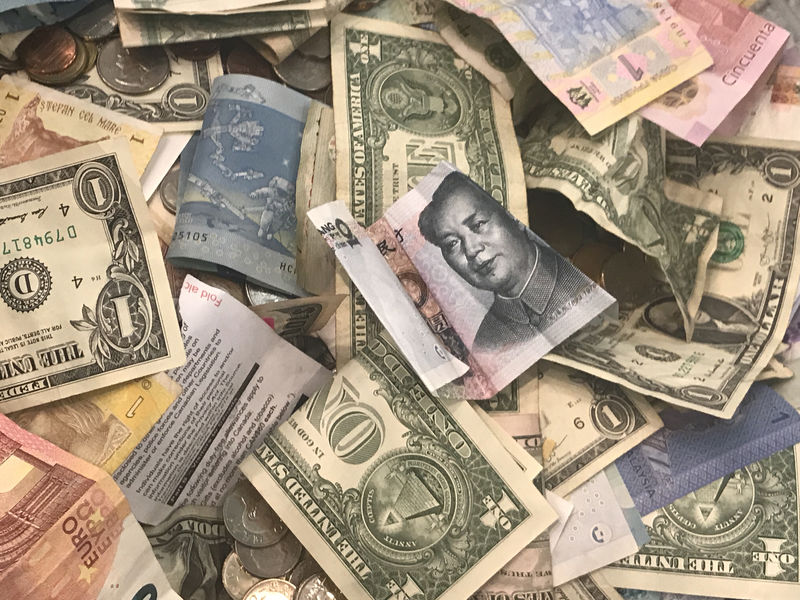By Tommy Wilkes and Karin Strohecker
LONDON (Reuters) - Emerging market currencies have had one of their worst years in a decade, but bruised investors tempted by what they see as cheap valuations are hoping the U.S. dollar's eight-month resurgence will end and the world won't tip into recession.
Emerging markets were touted by some of the biggest asset managers as one of the investment plays of 2018. But despite a rebound in November, emerging equities, bonds and currencies are in fact down sharply this year.
Defying predictions for a mid-year recovery, MSCI's emerging market currency index is down 4.5 percent in 2018, and 7.5 percent from the March peak (MIEM00000CUS).
And that assumes you spread the risk, avoiding the howling year-to-date losses of 30 percent in Turkey's lira
MSCI's emerging equity index (MSCIEF) is down nearly 16 percent.
So what has changed to encourage another bout of optimism?
Last month, emerging currencies and stocks staged their best performance since January while investors pumped in $34 billion, the most in 10 months, Institute of International Finance data showed.
December is proving less rosy, but the main catalyst for the tentative bounce is a repricing of Federal Reserve policy: Fed watchers mostly see the central bank raising interest rates once in 2019, instead of previous expectations of three times.
The resulting dollar decline has eased pressure on countries with hard currency debt.
Investors also say the panic in August and September might have been overdone. Since then, central bank action in the hardest-hit markets has restored some confidence.
"A lot of these emerging market currencies have discounted a lot of bad news quite significantly," said Tony Finding, portfolio manager at M&G Investments.
EM currencies against the dollar - https://tmsnrt.rs/2Qeh6wU
One big difference from previous selloffs such as the 1997 financial crisis is that developing countries have smaller proportions of their debt in dollars. Foreign currency-denominated debt stands at 14 percent of GDP versus 17 percent in 1999.
This leaves them slightly less vulnerable when U.S. interest rates and the dollar rise.
Also, unlike in 1997, most emerging-market countries freely float their currencies. Flexible exchange rates can absorb pain from slower economic growth and external shocks faster and support recoveries, although this feeds higher inflation.
Repeated interest rate hikes in the likes of Turkey, Indonesia and Mexico have helped reassure markets that central banks retain some policy independence after concerns about increasing political control over their coffers.
These rate rises have translated into hefty inflation-adjusted, or "real", bond yields.
Bob Michele, CIO for fixed income at JP Morgan Asset Management, said emerging 10-year real yields averaged around 4-5 percent versus zero in developed markets. "So the real yield differential is very, very high," he said.
Finding of M&G has been buying Turkish bonds, reckoning the economy's worst travails are over. Data on Tuesday appeared to support him: Ankara's current account was in surplus for a third month after years of deficit.
UNDERVALUED
From 16-month lows in September, emerging currencies have rebounded close to 2 percent. According to a commonly used measure of a currency's value - the real effective exchange rate (REER) - currencies outside Asia are undervalued.
REER measures the inflation-adjusted value of a currency against its trading partners.
Investors compare current values with long-term averages, typically over 10 years. The expectation is prices eventually return to those equilibriums, although many are skeptical about REER's predictive ability.
REER indicates Turkey's lira is 22 percent undervalued versus 10-year averages and Brazil's real nearly 19 percent so, while Mexico's peso and Russia's rouble are both around 15 percent undervalued.
Emerging markets real effective exchange rates - https://tmsnrt.rs/2RmtMi6
Undervaluation could help lift emerging currencies 5-8 percent over 12 months, said Ben Jones, strategist at State Street (NYSE:STT) Global Advisors.
"PROVE IT"
Emerging assets have proved more resilient in the most recent selloffs: Stocks suffered less than developed peers, and currencies firmed in November even though the dollar strengthened.
JP Morgan's Michele said the Fed was "clearly indicating" it was near ending its rate-hiking cycle. "A strong dollar and the Fed raising rates ultimately helped pull the liquidity cushion out from under emerging markets, so that big dynamic, we are expecting to end," he told Reuters.
The downside is that any U.S. slowdown could hurt developing economies. Previous downturns such as the 2008-2009 financial crisis hit emerging assets, too.
Goldman Sachs (NYSE:GS) analyst Caesar Maasry predicts more upside for emerging markets but says the sector has historically been unable to rally for more than two months without improved growth.
"Macro investors are in 'prove it to me' mode vis-a-vis emerging market growth," Maasry said.
Another unknown is China's yuan, to which emerging currencies show an increasing correlation.
China's currency is flirting with 7 yuan per dollar
Optimists reckon Beijing can stave off the worst with more stimulus. State Street's Jones calls 7-per-dollar a "psychological line in the sand".
"Emerging market fundamentals look better and China is not collapsing," he said.
Chinese stimulus and yuan - https://tmsnrt.rs/2zOBqe3
